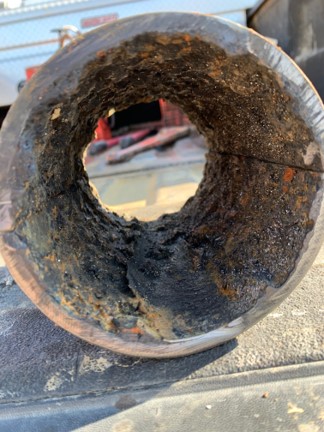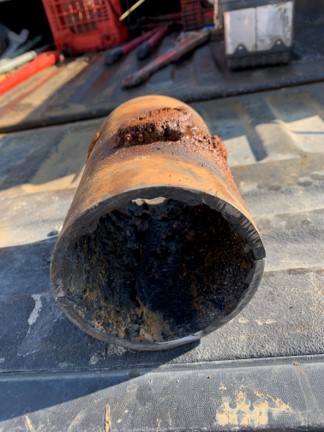Corrosion Allowance
Corrosion Allowance Formula
|
||
|
\( CA \;=\; CR \cdot DL + MS \) (Corrosion Allowance) \( CR \;=\; \dfrac{ CA - MS }{ DL } \) \( DL \;=\; \dfrac{ CA - MS }{ CR } \) \( MS \;=\; CA - CR \cdot DL \) |
||
| Symbol | English | Metric |
| \( CA \) = Corrosion Allowance | \(n\) | \(mm\) |
| \( CR \) = Corrosion Rate | \(in \;/\; yr\) | \(mm \;/\; y\) |
| \( DL \) = Design Life | \(yr\) | \(y\) |
| \( MS \) = Safety Margin | \(dimensionless\) | \(dimensionless\) |
 Corrosion allowance, abbreviated as CA, is the amount of material in a pipe or vessel that is available for corrosion without affecting the pressure containing integrity. The amount of extra material added to a structure or component in order to compensate for the loss of material due to corrosion over time. Corrosion is a natural process that occurs when metal structures or components are exposed to a corrosive environment, such as seawater or acidic gases.
Corrosion allowance, abbreviated as CA, is the amount of material in a pipe or vessel that is available for corrosion without affecting the pressure containing integrity. The amount of extra material added to a structure or component in order to compensate for the loss of material due to corrosion over time. Corrosion is a natural process that occurs when metal structures or components are exposed to a corrosive environment, such as seawater or acidic gases.
 The corrosion allowance is typically specified by engineers and designers based on the expected lifespan of the structure or component, the corrosivity of the environment, and the type of material used. The amount of corrosion allowance required can vary widely depending on these factors, but it is generally specified as a percentage of the original material thickness.
The corrosion allowance is typically specified by engineers and designers based on the expected lifespan of the structure or component, the corrosivity of the environment, and the type of material used. The amount of corrosion allowance required can vary widely depending on these factors, but it is generally specified as a percentage of the original material thickness.
In all piping systems, the expected corrosion rate may be constant or change with time. External corrosion (atmospheric corrosion, dampness in the soil, or chlorides from insulation) may be a factor. Many companies usually specify a 1/16-inch (0.0625") minimum corrosion allowance for carbon steel and low alloy steel piping if the corrosion rate can be predicted accurately and is less than a defined threshold (3 mils per year or less as an example). For stainless steel, a 1/32-inch (0.0 3125") minimum corrosion allowance is usually sufficient.
Corrosion allowance is an important consideration in the design and maintenance of structures and components that are exposed to corrosive environments. By adding extra material to compensate for the loss of material due to corrosion, engineers and designers can help ensure that the structure or component will last for its intended lifespan without failure due to corrosion.
Corrosion Rate - The anticipated rate at which the material will corrode is a crucial factor. This rate depends on various factors such as the type of material, the corrosive environment, and the presence of any corrosive substances.
Service Conditions - The conditions under which the equipment will operate play a significant role. Factors such as temperature, pressure, fluid velocity, and the presence of impurities in the fluid being transported or stored can affect the corrosion rate.
Material Properties - The type of material used for construction affects its susceptibility to corrosion. Certain materials, such as stainless steel or corrosion resistant alloys, may require a smaller corrosion allowance compared to carbon steel or other less corrosion resistant materials.
Design Life - The expected lifespan of the equipment or structure is an important consideration. The corrosion allowance should be sufficient to ensure that the equipment remains operational and safe throughout its intended service life without the need for premature replacement or repairs due to excessive corrosion.
Cost Considerations - While it is essential to provide adequate corrosion allowance to ensure the integrity and longevity of the equipment, an excessively large corrosion allowance can increase material costs and fabrication expenses. Balancing the need for corrosion protection with economic considerations is important.
Regulatory Requirements - In some industries or regions, regulatory standards may dictate minimum corrosion allowance requirements for specific types of equipment or operating environments. Compliance with these regulations is essential to ensure safety and regulatory compliance.
Risk Assessment - Conducting a risk assessment can help identify critical areas where corrosion is more likely to occur and where a larger corrosion allowance may be warranted to mitigate potential risks to safety, environment, or operational integrity.
By considering these factors, engineers and designers can determine an appropriate corrosion allowance that balances the need for corrosion protection with practical and economic considerations while ensuring the safety and integrity of the equipment or structure over its intended lifespan.
It's important to note that the actual calculation and determination of corrosion allowance can vary depending on specific industry standards, engineering practices, and regulatory requirements. Therefore, it's advisable to consult relevant codes, standards, and experienced professionals when determining the appropriate corrosion allowance for a particular application.
Corrosion Allowance Standards
- ASME B31G - Manual for Determining the Remaining Strength of Corroded Pipelines

